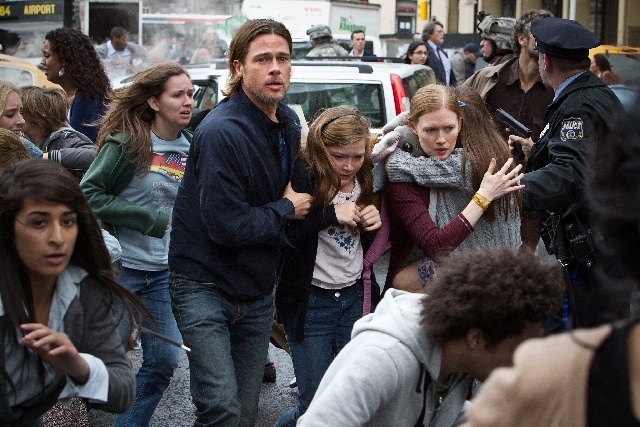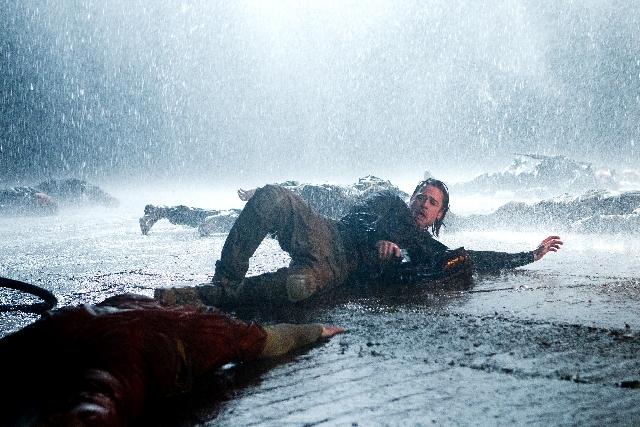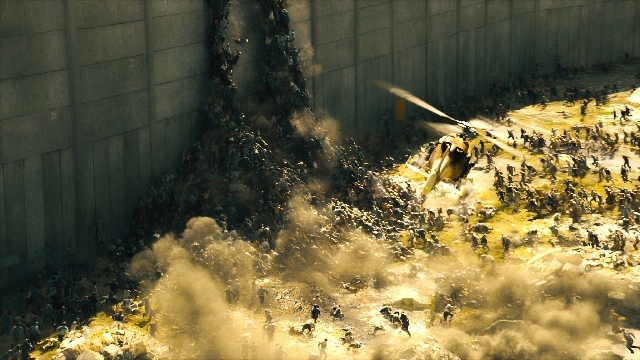Would you pay $50 to see a flick? Some fans did



NEW YORK — So this was the deal: For $50, you got to see Brad Pitt’s hotly anticipated zombie thriller “World War Z” before all your friends. You also got 3D glasses to keep, popcorn and sodas, a poster, the DVD when it comes out, and an intimate dinner with Brad.
Just kidding! No dinner with Brad.
But hundreds of fans did pay $50 for the other stuff last week in a small-scale marketing experiment in five theaters — and the studio, Paramount Pictures, says it worked well. With all the recent talk about future movie ticket prices climbing into the stratosphere, is it a harbinger of things to come?
Before you scoff, it’s worth noting that premium pricing happens all the time: in Broadway theaters, where you could get second-row seats for Tom Hanks in “Lucky Guy” this week if you paid $300 a pop, or at concerts, where you could pay well over $1,000 for, say, a Rolling Stones VIP package. At Yankee Stadium, a top-tier Legends seat can also top $1,000 per game, but season holders can get perks like a free trip to spring training.
Still, the idea of $50 for a movie strikes a lot of fans the wrong way.
“That’s possibly the craziest thing I’ve ever heard,” said Dillon Mahoney, 19, a student at the University of Pennsylvania, waiting in line for a regular “World War Z” showing. “I have a hard time paying 50 bucks for a Phillies game!”
“That’s my dinner,” noted another Philadelphia moviegoer, Cheyanne Farmer, 15. “That’s my allowance,” added Rahyaan Hall, her friend. “For a month.”
In New York though, one fan did some quick calculating and saw a reasonable value. “With the DVD and all those other things you mention, it probably comes to more than $50,” said Alex Leighton, 24, who’d just bought tickets to “World War Z.” “So you’re getting more than the movie.”
That’s the point that Paramount wants to make.
“This ended up being a headline that didn’t really represent what the offer was,” says Megan Colligan, the studio’s president of domestic distribution and marketing. “These people stepped up and made their commitment to us, and we gave them a great experience.”
That experience, which involved just one show each at five theaters across the country, included not merely seeing the film two days early and the free stuff; the “mega-ticket” buyers also got to bring friends along at regular price and they got a party atmosphere, including a DJ and photo booths.
Colligan says that four of the theaters sold out — they averaged 250 seats each — and one was 80 percent full. She wouldn’t get more specific in terms of revenue, but said: “It was a fun, positive experience for everyone.”
The offer might have gone largely unnoticed, had it not been for its timing: The special showings came just a few days after Hollywood heavyweights Steven Spielberg and George Lucas, speaking at the University of Southern California, issued dire predictions about the future of movie prices, with Lucas estimating tickets could end up at “$50, maybe $100, maybe $150,” and Spielberg predicting differentiated pricing according to a film’s budget — with the next “Iron Man” costing $25 perhaps, but the next “Lincoln” costing $7.
How realistic were those projections? As for the Lucas estimates, there’s no way prices could reach that high, says Tom Adams, analyst and director of U.S. media for IHS Electronics & Media. “I just don’t see what we could add to the experience to make it worth that much,” he says.
But differentiated pricing is much more realistic, he says. “When you think of it, it’s strange to have an industry where every product costs the same, no matter how good or popular,” he says. “I think consumers are smart — they can figure out that ‘Avatar’ costs a lot more to make than a romantic comedy. And we see with 3D movies that price flexibility is possible, for a different viewing experience.”
At Paramount, Colligan points out that her studio’s $50 experiment is not really about Lucas’ dire price projections, but about the need to find new, creative ways to market the movie experience, both in theaters and at home.
“This is all part of wanting to take risks, to develop new strategies of how we do business,” she says. “There’s going to be more experimenting to come. You can’t do what you did 10 years ago and have the same results.”
The advantages of a “mega-ticket”-like scheme, if people go for it, are clear for the studio (Paramount partnered with Regal Entertainment Group, the large movie-theater circuit). First, you get customers buying the DVD at the same time they see the movie, rather than buying it later and only if they really loved the film.
Perhaps even more important, you help generate early buzz, with moviegoers spreading the news on social networks two days before opening. It’s like having theaters full of critics ready to post their reviews — but here, the critics are fans, predisposed to loving the film.
The upside for fans? They get to see the film early — not a small thing, depending on the fan and the movie. It may work even better for installments of huge franchises, mused Leighton, the New York movie fan, and his friend, Florian Baier, 22.
“I wouldn’t have done it for this movie, but maybe for the next ‘Star Wars’ film or maybe ‘Lord of the Rings,’” Leighton said. “I’d also be checking the online reviews — I’d have to know the movie was good.”
Added Baier: “I wouldn’t do it for the DVD. That is not a draw.” Leighton agreed: “There are easier ways to watch online. If I even have the time.”
Note to studios: Maybe you should think about offering that dinner with Brad, after all.
———
Keith Collins reported from Philadelphia.












